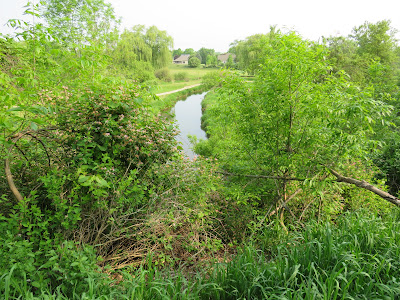The morning temperature is 60 degrees under a sunny, hazy sky as I stand on the Leaton Rd. bridge and watch a Muskrat swim with the slow-moving current along the edge of Salt Creek. Looking around, I spot a female Redwing Blackbird near her nest while far upstream a couple of swimming Mallard drakes catch my attention. Exploring the bank, I come upon a Red maple tree displaying clusters of winged seeds, sometimes called “spinners” or “helicopters” due to their characteristic descent to the ground. These seeds are reddish, in contrast to the more common Sugar maple, which are green in spring. Soon they will disperse, unlike Sugar maple seeds that hang on until the fall. Driving northeast to the Fremont Rd bridge, I watch the creek flow through a more “natural” channel while overhead, I see a Catbird perching in one of the many leafless, lifeless Ash trees. While passing through an adjoining meadow, I notice little masses of sticky, frothy bubbles, on young Goldenrod plants. These white foam blobs are produced by the nymphs, of spittlebugs, small insects related to aphids and other true bugs (stock photo). The foam serves a number of purposes, including protecting the nymph from predators as well as providing insulation from temperature extremes and a low humidity. Heading back to the car, I look up and listen to a perching Song Sparrow. After driving to my third encounter with Salt Creek, I’m hiking along the edge of a golf course, just south of the village of Shepherd. From one tree, high overhead, I hear the song of a Baltimore Oriole while from another, I spot an Eastern Kingbird. This bird is a long-distance migrant, wintering entirely in South America. They migrate in flocks and unlike many of the migratory songbirds, they travel mostly by day. From a downed tree in the underbrush, I get a close look at a sitting Eastern Chipmunk. Finally, as I watch the creek water flow rapidly north, I think about the identify crisis of this watercourse. While current maps label it “Salt Creek.”, maps in the 1800’s called it “Salt River”, which was also the name of the village that is now Shepherd. Likewise, the graveyard south of the village is still called Salt River Cemetery and the village park is called “Little Salt River Park. However, there is another watercourse that runs through the middle of Isabella and Midland Counties that currents maps label “Salt River” (stock photo). To confuse matters more, this creek that meanders through this golf course was once named “Winding Brook” while the current owners call it “Maple Creek."
Buzzard soars so well
Amazing sense of smell
Flies with grace, flies high
On the wind, azure sky
With others, just a few
Keen eyes, quite a view
Skillful and smart
Black bird, thou art
I watch and praise
Turkey Vulture’s ways
D. DeGraaf




